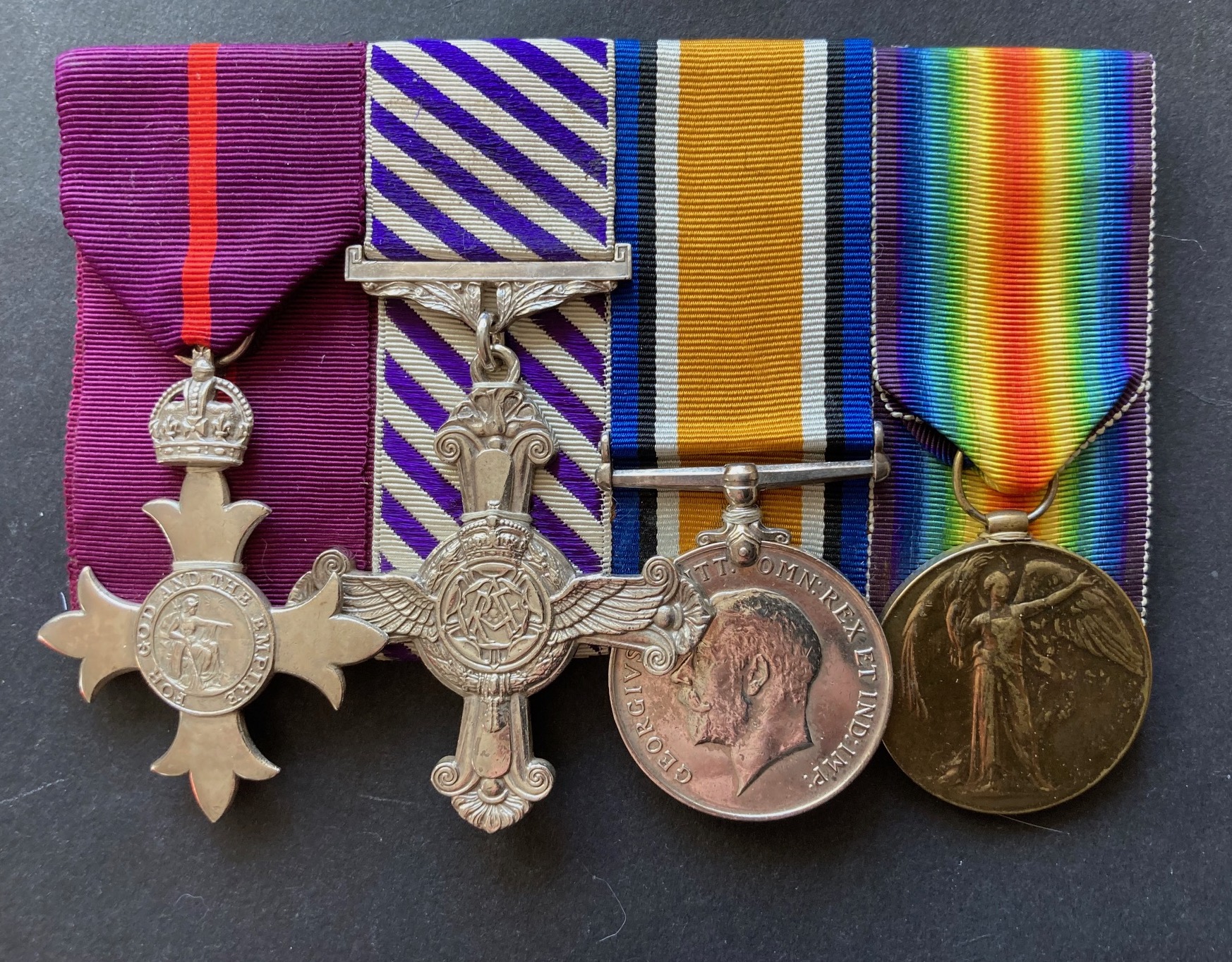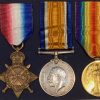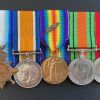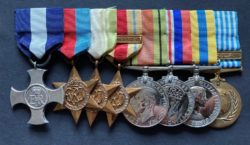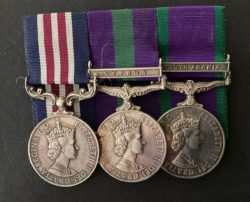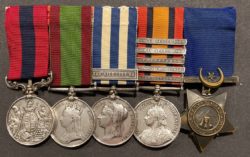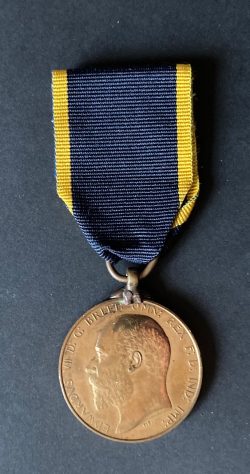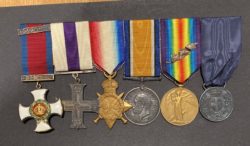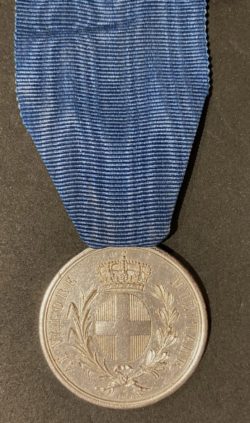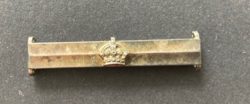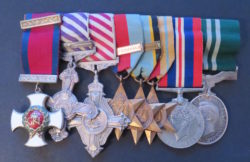Especially fine D.F.C. ‘Ace’ S.E.5a scout Pilot with 6 victories,1923 M.B.E. 1st type (Military) for night flying test pilot services, air racer and commercial stunt pilot. Lieut. Leslie ‘The Flying Gypsy’ Hamilton. Lost his life in August 1927 during the “1st attempted East-West Atlantic crossing”, attracting a $25,000 prize after Charles Lindbergh had completed the first Atlantic crossing from West-to-East in May the same year. Despite rating their chances at not better than 50% he set out with Freddie Minchin DSO MC with about 42 hours of fuel for an anticipated 37 hour flight , and as passenger, Princess Anne of Löwenstein-Wertheim-Freudenberg, Hamilton’s long term friend, financial backer and owner of the aircraft, who sat behind among spare fuel cans, carrying her hat box, thermos flask and sat upon her wicker chair. Just before take off emptied his pockets of £25 and giving it to his great friend. Freddie West V.C. to give to the mechanics ‘ Besides, he observed, ‘It’s better they have it than the fishes….Goodbye old man’
£6,450.00
Out of stock
M.B.E. 1st type (Military) , Distinguished Flying Cross, (GV)., British War Medal, Victory Medals (Lieut. R.A.F.)
Member of the British Empire 1st type (Military) London Gazette 2 June 1923. Flying Officer Leslie Hamilton, D.F.C., Royal Air Force.
Original recommendation – Flying Officer Leslie Hamilton “This officer has shown the greatest keenness and ability as a Pilot in carrying out a considerable amount of night-flying during the winter of 1922-23, in connection with lighting experiments conducted by the Controller of Communications. The collection of data has been of great value to both service and civil aviation and has been made possible by his very marked devotion to duty and entire disregard of his own personal safety under extremely adverse weather conditions.”
Distinguished Flying Cross London Gazette 8 February 1919. Lieut. Leslie Hamilton. (SALONIKA).
“A gallant and skilful scout pilot who never hesitates to attack enemy formations, however superior in numbers. During recent operations he has rendered exceptional service. He has himself brought down, or assisted to bring down, six enemy machines.”
Leslie Hamilton born 1897 India. Having first served with the Inland Water Transport, Royal Engineers as a Temp. 2Lt. Royal Engineers, serving st Basrah, Iraq from 12 June 1916 then transferred to the R.A.F. 27 Aug. 1917, served at 58 Training Squadron and qualified as a Pilot 27 Feb. 1918 and served in 17 Squadron until the Squadron was amalgamated with 47 Squadron to form 150 Squadron in Salonika in April 1918. The Squadron was formed to fight on the Salonika Front in Greece-Bulgaria where Britain aided Greece in fighting Bulgaria of the Central Powers. German Artillery Officers and air units served with the Bulgarians. The Salonika Front was extremely difficult due to lack of supplies, which resulted from rough terrain and the distance from Great Britain.
Hamilton was one of 10 Aces on 150 Squadron. He scored 6 victories flying the S.E.5a in 1918. Flying Officer 14 Oct. 1919, relinquishes his commission 28 Nov, 1919. Graduate of R.A.F. College, Cranwell, 15 March 1921, joined 24 Squadron at Kenley 10 April 1922. Granted Short Service Commission as Flight Lieutenant, 2 June 1923, granted permanent Commission, 5 Sept. 1923 – Promoted Flying Officer on half-pay, 15 Sep 1925 – Restored to full-pay, 19 Sep 1925 served with 20 Squadron Army-Co-operations Squadron, India 15 Oct. 1925 and retired 1926.
Victories flying S.E.5a’s, 150 Squadron.
21 Apr. 1918 11.15am 17 Sqn. DFW C.V. Out of Control, Barakli-Dzuma.
04 May 1918 10.40am 150 Sqn. DFW C. captued, Marian Aerodrome. Crew killed.
15 June 1918 09.30am 150 Sqn. Albatros D.V. Out of Control, Dragotin.
23 June 1918 07.45am 150 Sqn. Albatros D.V. Destroyed, Hill 5401, Rupel Pass.
04 Sep. 1918 10.55am 150 Sqn. C Type, Destroyed, North of Karusu Bridge.
18 Sep. 1918 07.00am 150 Sqn. Fokker D.VII, Out of Control, Karali.
In the 21 April 1918 action combat report states against D.F.W. Aviatik. 2 seater, forward and Observers guns. “The DFW was observed by SE5a B.694 (HAMILTON) flying South over Barakli Dzuma. It was engaged by B.694 (Hamilton) who fired 50 rounds from forward gun. Subsequently the DFW was engaged by SE5a B.690 (Goulding), the enemy machine at the time was diving steeply for Rupel Pass. SE5a B.694 (Hamilton) again dived on enemy machine, firing 150 rounds from close range. The hostile Observer was seen to be out of action and the hostile machine was observed to be slipping from side to side. After B.690 had again dived on enemy machine B.694 (Hamilton) engaged it from underneath at 20 feet firing a drum of Lewis into the fuselage of enemy machine. The E.A. fell away in a vertical dive N. of Kula. The actual crash was not observed as B.694 rejoined B.690.”
4 May 1918 – “S.E. while on patrol at 13,000ft observed a DFW escorted by 2 DIII’s or DV’s. S.E.5 followed the other S.E.5 and engaged the two-seater at close range firing 100 rounds. EA was observed to go down completely out of control, gliding on its back and followed by both SE5’s, eventually crashing near MARIAN Aerodrome, both occupants being killed. The enemy scouts did not attempt to take part in combat.”
15 June 1918 – Against 10 E.A. of D111, DV and Siemens-Schukurt type. “While escorting reconnaissance to Marrinopolje I dived on hostile machine (Siemens-Schukurt) attempting to attack AW. EA dived on AW but I followed it down, firing continuously, to 6,000 ft. when EA appeared to go out of control. S.E.5 then pulled up to rejoin others as three EA were in the vicinity.”
23 June 1918 – “After escorting bombing raid to Marinopolje, S.E. formation returned to attack several EA’s over RUPEL. Leader dived on one DV scout and I followed him firing 50 rounds from front gun. Leader broke off and EA flattened out at 9,000 ft. and manoeuvred for firing position. I succeeded in getting on EA’s tail and fired 250 rounds from both guns at close range. EA dived and half spun and was seen to crash near hill 5401 by Capt. Bell and Lt. Boyd-Harvey.”
4 Sept 1918 – Against 1 enemy two-seater Roland. “Whilst returning from Recon. I noticed EA 2,000 ft. below. I dived down and fired many bursts into EA which manoeuvred down to 1,000ft followed by Lt. Travers and myself both firing at favourable opportunities. After firing a good burst at 50ft. from ground, EA landed and turned upside down in a field. One man got out from underneath EA and ran into some bushes. Field is about 1/2 mile N. of Karasu Bridge next to the river.”
18 Sept 1918 – against 5 Fokker Biplanes (DVII’s). 7 other E.A. seen at varying heights. “While on patrol with Capt. Bell, Capt. Brawley and Lieut. Beeney we encountered 5 Fokker Biplanes in formation. During engagement which lasted an hour, I, on one occasion, succeeded in getting a good burst into one EA which apparently went down out of control, but was not observed to crash owing to close engagement with the other 4 EA’s. At other periods during combat I fired altogether 150 rounds from Vickers Gun at different EA’s.”
After the war, Hamilton became a test pilot, earning the M.B.E. in that capacity. In 1922 he was serving in No. 24 Squadron, based at Kenley, and in June he took part in the 3rd RAF Aerial Pageant at Hendon Aerodrome, coming second in a race between Avro 504s, and with the rest his squadron giving a demonstration of formation flying in Bristol Fighters. In September the same year he took part in the first King’s Cup Race, flying an Airco DH.9C belonging to Princess Loewenstein-Wertheim, who flew with him as a passenger. They came sixth.
In July, 1923 he took part in the Fourth RAF Aerial Pageant, again taking part in the Avro 504 race, and again coming second. He was granted a permanent commission in the RAF on 5 September.
In July 1924 he took part on the Fifth RAF Aerial Pageant, as part of team representing Kenley in an aerial relay race. Each team consisted of an Avro 504, a Bristol Fighter and a Sopwith Snipe, with Hamilton flying the Avro in the winning team. No. 24 Squadron mounted another Aerial Pageant at Kenley in a week later organised by the Air Ministry and the Empire Press Union for the benefit of 170 members of the Canadian Weekly Newspaper Association. Hamilton, flying an Avro 504, gave a demonstration of stunt flying. Hamilton was posted to the Inland Area Aircraft Depot at Henlow on 17 September 1924, and on 3 December was placed on half-pay. He was restored to full pay on 15 September 1925, only to resign his commission for good on 19 September.[22]
In 1926, Hamilton took up stunt flying and was called the “Flying Gypsy”. His great friend Freddie West, VC later recalled, “he became known as ‘The Flying Gypsy’ and a rattling good pilot he was. In fact, Hamilton was mad on music and a great charmer. The girls fell for him by the dozen. He was handsome, dark and debonair, very happily married, bubbling over with vivacity, always gay, and on top of all of that he had this dare-devil flying reputation – enough to make a girl swoon. He played piano beautifully – mostly jazz in those days, but he could play anything. With all his attractions for the fairer sex he was a man with no conceit in his makeup. The result was that he was very popular.”
Charles Lindbergh had completed the first Atlantic crossing from West-to-East in May 1927, and pressure was building for an East-West crossing, attracting a $25,000 prize. Princess Lowenstein-Wertheim wanted to be the First woman to accomplish the Atlantic crossing flight. Freddie West, V.C. continues. “In August 1927, Freddie West found himself hosting a trans-Atlantic flying attempt from RAF Upavon, where he was Adjutant. He was delighted to discover that Hamilton would be part of the team, together with Colonel F.F. Minchin, CBE, DSO, MC, an Imperial Airways Pilot and Princess Lowenstein-Wertheim, a glamorous and determined lady who was anxious to make the first East-West crossing, a distance of 2,700 miles to the intended landing place in Ottawa. Freddie West, however, quickly discovered that Hamilton only rated their chances at around 50 percent. ‘This time’, said Hamilton in confidence to his friend. ‘I’d rather be a rank outsider on any racecourse in England.’
Aware that backing out would have an appalling comeback in the media, Hamilton was adamant that the flight would go ahead. He was perfectly resigned to his fate, ‘If I go out, it’s the way I’d like to go out.’ Recent publicity had announced a rival in the form of an American millionaire named Levine, and Minchin was as anxious as the Princess that everything must proceed soonest. When the news of yet another rival was reported, the Princess telephoned Upavon to tell Minchin and Hamilton for an early start the following day. ‘She’s worth fourteen gallons of petrol, nearly an hour in the air, if you count her wicker armchair and her hatboxes and her thermos flask and so on’, he told West, who was by now very worried about Hamilton’s morale. Moments later he went on to confirm a premonition of disaster, ‘I’m afraid it’s goodbye to all this, goodbye to my family. Goodbye to old England and the RAF boys.’ Given the anxiety which Hamilton was going through, West was very impressed by his outward bearing, ‘Cool as a cucumber’, no less.
Their plane, a Fokker FVIIa, named ‘St. Raphael’, had been the centre of attention among West’s men but the arrival of the Princess in her Rolls-Royce at dawn on 31 August 1927, sent the Officer’s Mess into near chaos. Sporting ‘off-mauve coloured riding breeches, a blouse under a leather jacket of the same colour, yellow tan, high heeled riding boots with heavy fur edging and a kind of Napoleonic-looking black straw hat on her head, with a brim that fell downwards over her ears’, she appeared very relaxed. She did however, ask for some brandy in her coffee before departing for the hangar.
Hamilton, meanwhile, thrust 25 Pounds at West to give to the mechanics who had so ably looked after the ‘St. Raphael.’ Besides, he observed, ‘It’s better they have it than the fishes….Goodbye old man, and thanks for all you have done for us.’ It was to prove their final exchange. Princess Lowenstein-Wertheim was a remarkable lady, born Lady Anne Savile on the 25th May 1865 at Methley Hall, the ancestral home of the Earls of Mexborough in Yorkshire. She was the second daughter of John the 4th Earl who owned the Church and his wife Agnes who was the niece of Alexander Raphael, who built the Church. She married on the 15th May 1897 HSH Prince Ludwig Karl zum Lowenstein Wertheim and spent part of her honeymoon at Ditton Lodge, Thames Ditton. Her marriage made her a German citizen. The Princess was a widow after only a year and 10 months as Prince Ludwig died fighting for the Spaniards against the Americans in the Philippines on the 26th March 1899. In June 1914, the Princess aged 49, took flying lessons with Mr. Baumann of the Beatty Flying School in a dual-control Handley Page bi-plane. After the Great War she regained her British nationality. At the age of 62 in 1927 the Princess funded an attempt to be the first woman passenger to fly the Atlantic from East to West in a single-engine Fokker F VIIa monoplane, named ‘St. Raphael.’ The plane was Blue and Yellow in colour and was registered G-EBTQ. The plane was blessed by Dr. Mostyn, Archbishop of Cardiff at dawn on the 31st August 1927. They took off at 07.33 from Upavon, Wiltshire on the 3,600 mile flight to Ottawa, Ontario in Canada. Her two pilots were both War heroes, Lieutenant-Colonel Freddie Minchin, DSO, MC, and Captain Leslie Hamilton, MBE, DFC. The Princess sat in a wicker chair in the rear with 8 tanks of petrol, enough for 44 hours of flying, on a trip expected to take 37 hours.
The Fokker VIa was purchased in Holland for GBP £3,000 and was fitted with a 450hp Jupiter engine. Eight additional fuel tanks were installed in place of the seating, giving the aircraft a fuel load of 795 Gallons and a flying time of 40-42 hours. The take-off was dramatic. The Fokker, with an all up weight of 11,000 pounds, used every one of the 1,020 yards of Upavon’s runway before Minchin was able to lift it just clear of a road bank and barbed wire fence.
They were last sighted by the oil tanker Josiah Macy at 21:44 hours GMT (Airborne 14 hours) halfway across the Atlantic flying in a Westerly direction. The Prince of Wales, later King Edward VIII & The Duke of York, later King George VI, were both in Canada at the time and delayed their return to England to welcome the plane on its arrival in Newfoundland. Hundreds of people waited and watched all night, but the plane, the Princess and her two Pilots were never seen again. For years, searchers combed the Canadian wilderness for wreckage but nothing was ever found. Before disappearing, they had been averaging only 70 mph ground speed, far slower than the hoped for 100mph. A few days after their disappearance, scraps of a broken plane were found off the coast of Iceland. Among them was a wheel and a wicker chair. There was no doubt this was all that remained of the St. Raphael despite the fact that the bodies of the crew and passenger were never recovered. Editor’s (Buster’s) note:- this position around Iceland would make sense in that when they were sighted by the tanker half way across the Atlantic they were well behind the intended schedule, and if the crew failed to sight land (Canada) at the end of the prescribed time, they may have elected to turn towards what they thought would be Greenland in an attempt to take advantage of the tailwind (130 mph ground speed for 6-7 hours flying time remaining). However, if the winds were as described, they may have only passed below the tip of Greenland, and this return journey would place them in the vicinity of Iceland. Instead of being the First Woman to cross the Atlantic by air, Princess Lowenstein-Wertheim earned the dubious distinction of being the first woman to perish on a trans-Atlantic flight. Leslie Hamilton, WW1 “Ace”, sadly joined an ill-fated cadre of Aviation Pioneers including Charles Nungesser, Charles Ulm, Amelia Earhart and Charles Kingsford-Smith.
In 1928, a number of lakes in the northwest of the province to honour aviators who had perished during 1927, mainly in attempting oceanic flights. The main lake so named is St Raphael Lake named for the Saint Raphael; similarly-named lakes in the same general vicinity include Hamilton Lake, , Minchin Lake, and Wertheim Lake which commemorates the Princess
A large memorial plaque commemorating the fateful flight and dedicated to Anne, Captain Hamilton and Colonel Minchin hangs in St Raphael’s church, Kingston upon Thames.
File of extensive research – Combat Reports, 17/150 Sqd’s Salonika 1918 work, Service Papers, Casualty Forms, M.I.C., London Gazette’s, Air30 for M.B.E., Newspapers re loss, ‘Famous 1st Flights across the Atlantic’ etc.
Died: 31 August 1927 – North Atlantic Ocean (30 years old) attempting 1st East-West Atlantic crossing.
Provenance Sothebys March 1982.
